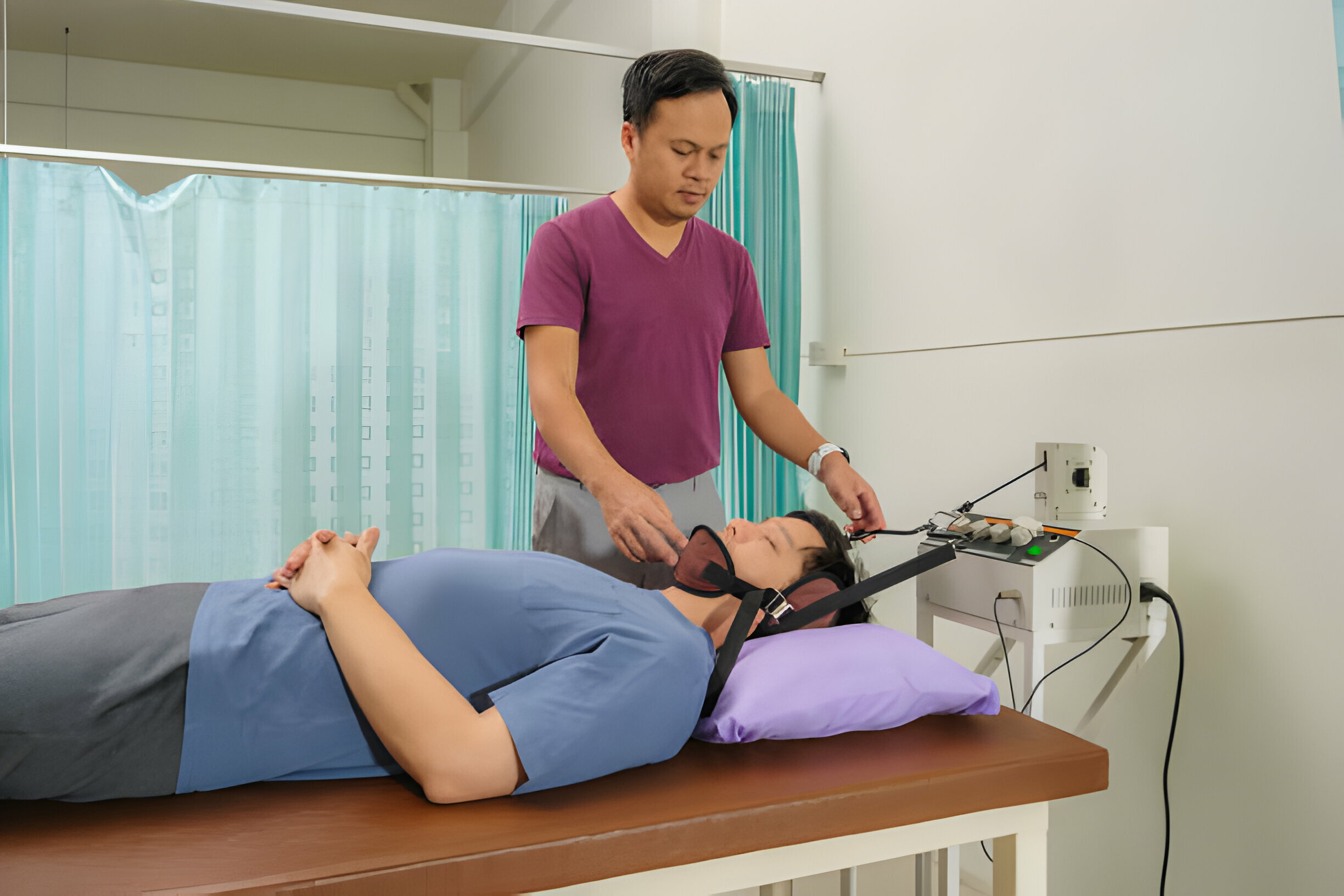Are you tired of living with constant discomfort and pain? Look no further than chiropractic traction! This revolutionary treatment method uses a traction table to provide relief for conditions like back problems, sciatica, joint pain, and carpal tunnel. By aligning your spine without direct pressure, chiropractic traction mobilizes your spinal column, increases blood flow, and improves balance and strength. Say goodbye to herniated discs and spinal injuries as this results-oriented approach offers lasting relief. Discover the wonders of chiropractic traction today!
The Definition of Chiropractic Traction
Chiropractic traction is a therapeutic technique that involves using weights or forces to stretch muscles and ligaments, providing relief from pain caused by pinched nerves or injuries. Traction therapy is defined as the use of these weights or forces to gently stretch and elongate the spine, promoting spinal health. The techniques used in traction therapy can vary, including manual techniques performed by the chiropractor or mechanical techniques utilizing specialized tables. The benefits of traction therapy are numerous. It helps to reduce pressure on spinal nerves, increase spinal motion, and provide a conservative alternative to surgery for herniated discs. Traction therapy has shown effectiveness in reducing symptoms of sciatica and improving overall spinal health and function. Therefore, if you are experiencing pain or discomfort related to pinched nerves or injuries, traction therapy may be a beneficial treatment option for you.
How Chiropractic Traction Works
When you utilize a traction table, it gently stretches and mobilizes your spinal column, providing relief from discomfort and promoting improved mobility. Chiropractic traction offers numerous benefits for athletes, including enhanced flexibility and range of motion, reduced muscle tension, and accelerated recovery from injuries. It also plays a vital role in post-surgical rehabilitation by aiding in the healing process, reducing scar tissue formation, and restoring normal function to the affected area. Furthermore, chiropractic traction is highly effective in relieving neck pain by decompressing the cervical spine and alleviating pressure on the nerves. Pediatric patients can also benefit from chiropractic traction as it helps improve posture and spinal alignment during their growing years. Overall, chiropractic traction is a valuable treatment modality that offers significant advantages for various conditions and patient populations.
Benefits of Chiropractic Traction
Utilizing a traction table can provide relief from discomfort, improve mobility, and promote faster recovery from injuries. The benefits of chiropractic traction are well-documented through research, patient testimonials, and case studies. Research has shown that chiropractic traction effectively relieves pain associated with back problems, sciatica, joint pain, carpal tunnel, and more. It removes pressure from herniated discs and spinal injuries by creating space between vertebrae. This adjustable table allows patients to align their spine without direct pressure on it. In addition to pain relief, chiropractic traction mobilizes the spinal column and stretches muscles and ligaments. It increases blood flow and oxygen to inflamed areas, improving balance, mobility, and strength. Patient testimonials highlight the effectiveness of this treatment in providing lasting relief and speeding up recovery time.
Different Types of Chiropractic Traction
Different types of chiropractic traction can be tailored to individual needs and conditions, providing personalized treatment options for patients. Here are some key types of traction devices and therapy techniques commonly used:
- Traction for spinal decompression: This type of traction is designed to relieve pressure on the spine by creating space between the vertebrae. It can help with conditions such as herniated discs, bulging discs, and spinal injuries.
- Traction for herniated discs: Specifically focused on addressing herniated discs, this type of traction therapy aims to reduce pressure on the affected disc and promote healing.
- Traction for joint pain: Joint pain can be effectively treated using traction therapy techniques that aim to stretch muscles and ligaments around the affected joint, providing relief and improving mobility.
The Science Behind Chiropractic Traction
To understand the science behind traction therapy, you can explore how it gently stretches your muscles and ligaments to alleviate pain and improve mobility. Chiropractic traction has been the subject of numerous research studies, which have shown its effectiveness in reducing symptoms of back pain and improving spinal health. Case studies of patients who have undergone chiropractic traction have also demonstrated positive outcomes, with many experiencing significant relief from their discomfort. In sports injury rehabilitation, chiropractic traction plays a crucial role in promoting healing and restoring function by targeting specific areas of the body affected by the injury. By exploring the biomechanics of chiropractic traction, researchers have gained valuable insights into how it works to decompress the spine and relieve pressure on nerves. When compared to other non-surgical treatments for back pain, chiropractic traction has consistently shown comparable or better outcomes in terms of pain relief and functional improvement.
Who Can Benefit From Chiropractic Traction
Many individuals, including those with back problems, joint pain, and herniated discs, can benefit from chiropractic traction. Chiropractic traction is a treatment method that involves the use of weights and forces to stretch muscles and ligaments in order to alleviate pain caused by various conditions. Here are some key points about chiropractic traction:
- Chiropractic traction can be effective for treating spinal, muscle, and skeletal pain.
- It provides relief for herniated or bulging discs and disc degenerative disorders.
- Compared to other treatments, chiropractic traction offers a conservative option to surgery for herniated discs.
- Integrating chiropractic traction into therapy can improve overall spinal health and function.
When seeking chiropractic traction treatment, it’s important to find a qualified chiropractor who specializes in this technique. They will have the expertise and knowledge to provide appropriate care tailored to your specific condition.
What to Expect During a Chiropractic Traction Session
During a chiropractic traction session, you can expect to experience gentle stretching and decompression of your spine to alleviate pain and improve overall spinal health. Chiropractic traction techniques involve the use of weights and forces to stretch muscles and ligaments, providing relief for joint, vertebrae, muscle, and ligament injuries. This treatment is effective for conditions such as herniated or bulging discs, sciatica, back problems, and more.
To prepare for a chiropractic traction session, it is recommended to wear comfortable clothing that allows for easy movement. Patient testimonials on chiropractic traction highlight its effectiveness in reducing pain and improving mobility. Many patients have found long-term benefits from regular sessions, including faster recovery time and improved quality of life.
When comparing chiropractic traction to other therapies, it stands out as a non-surgical option that provides lasting relief without the need for medication or invasive procedures. Its ability to mobilize the spinal column and increase blood flow sets it apart as a holistic approach to spinal health.
Potential Risks and Side Effects of Chiropractic Traction
Experiencing potential risks and side effects from chiropractic traction can be minimal but it’s important to be aware of them. Here are some key points to consider:
- Potential Risks: While rare, there is a small risk of muscle soreness, fatigue, or temporary discomfort after a session. It’s crucial to communicate any concerns with your chiropractor.
- Effectiveness Studies: Research has shown that chiropractic traction can provide relief for various conditions, but individual results may vary. It’s essential to discuss expected outcomes with your chiropractor.
- Patient Testimonials: Hearing from others who have undergone chiropractic traction can offer valuable insights into their experiences and outcomes. Consider seeking testimonials or personal stories to gain a better understanding.
- Contraindications: Certain medical conditions like fractures, severe osteoporosis, or spinal infections may make chiropractic traction unsuitable for you. Consultation with a healthcare professional is crucial before undergoing treatment.
How Chiropractic Traction Differs From Other Treatments
Chiropractic traction offers a unique approach to treating spinal conditions compared to other therapies. The benefits of chiropractic traction are numerous, including relief from back problems, sciatica, joint pain, carpal tunnel, and more. By removing pressure from herniated discs and spinal injuries, this technique promotes healing and reduces discomfort. Chiropractic traction techniques involve using weights and forces to stretch muscles and ligaments, providing relief for pinched or compressed nerves. It is an effective treatment for joint, vertebrae, muscle, and ligament injuries as well as herniated or bulging discs. Research has shown the effectiveness of chiropractic traction in reducing pressure on spinal nerves and improving overall spinal health. Safety measures are taken by chiropractors to ensure a safe environment during treatments. With its proven effectiveness and safety precautions in place, chiropractic traction offers a compelling alternative for those seeking relief from spinal conditions.
Integrating Chiropractic Traction Into a Treatment Plan
Integrating chiropractic traction into a treatment plan can enhance the overall effectiveness of the therapy. Here are some ways you can incorporate chiropractic traction into your wellness routine:
- Combine chiropractic traction with acupuncture: By combining these two treatments, you can experience a synergistic effect that may provide even greater pain relief and improved mobility.
- Use chiropractic traction for chronic pain management: Chiropractic traction has been found to be effective in managing chronic pain conditions such as back problems, sciatica, and joint pain.
- Incorporate chiropractic traction into physical therapy: Adding chiropractic traction to your physical therapy sessions can help improve the outcomes by mobilizing the spinal column, stretching muscles and ligaments, and increasing blood flow to inflamed areas.
- Explore the role of chiropractic traction in sports medicine: Chiropractic traction can play an important role in sports medicine by aiding in injury recovery, improving flexibility, and enhancing athletic performance.
Finding a Qualified Chiropractor for Chiropractic Traction
Now that you understand the benefits of chiropractic traction and how it can be integrated into a treatment plan, the next step is finding a qualified chiropractor to provide this therapy. It’s important to do your research and find a chiropractor who has experience and expertise in performing chiropractic traction. Look for patient testimonials or reviews to get an idea of their success rate with this treatment.
In addition, when choosing a chiropractor, consider their facility and equipment. Ensure they have the right traction table that suits your needs. The table should be adjustable and able to align your spine without putting direct pressure on it.
While chiropractic traction can be effective for back pain relief, it’s also essential to explore alternative treatments and consult with healthcare professionals before making any decisions. Research on chiropractic traction can provide valuable insights into its effectiveness and potential risks.






